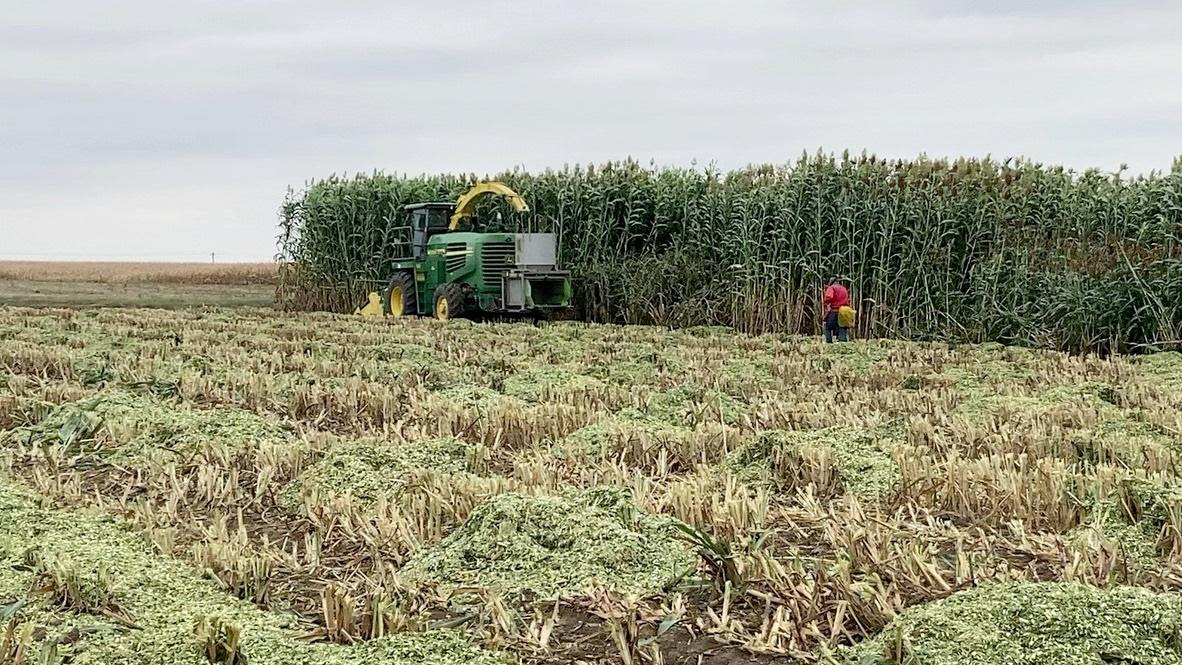|
News Bits
The U.S. corn and soybeans harvests advanced about as expected last week. Some harvest delays are likely during the early part of this week, but most of the Midwest and Plains should be able to make another round of solid progress.
The USDA says that as of Sunday, 15% of U.S. corn is harvested, with 93% of the crop dented and 60% mature, all faster than normal, while 53% is rated good to excellent, up 2% on the week.
12% of soybeans are harvested and 73% are dropping leaves, both ahead of the respective five-year averages, with 50% of the crop called good to excellent down 2%.
26% of winter wheat is planted, compared to 29% on average, while 7% has emerged, compared to the usual rate of 6%.
96% of spring wheat is harvested, matching its typical pace.
13% of cotton is harvested, in-line with average, and 65% of bolls have opened, a little more than normal for late September, with 30% of the crop in good to excellent shape, 1% higher.
66% of rice is harvested, compared to 59% on average.
28% of harvested, with 92% coloring and 58% mature, all close to normal, with 42% of the crop in good to excellent condition, 1% below the previous week.
36% of U.S. pastures and rangelands are rated good to excellent, a week-to-week increase of 2%.
Tyne Morgan, AgWeb.com
Move over Iowa, there's a new record farmland sale on the books. A piece of Missouri farmland underwent rapid-fire bidding, which racked the final price tag up to $34,800 per acre. The recent sale now beats out the previous record of $30,000 per acre in Iowa.
According to the bill of sale from Dyer and Fenner Auctioneers, the record sale happened last Thursday in Saline County, Mo. Two farmers got in a bidding war, and in just 15 minutes the 115 acres sold for $34,800 an acre, setting the new record.
The buyer wasn't an investor. The winning bid came from a farmer by the name of Jeff Baxter from neighboring Carroll County, Mo. According to area farmers, the competing bidder was a farmer who's home farm touches the land that was for sale.
Jim Rothermich of Iowa Appraisal says the bidding started at $15,000 an acre for the piece of ground that had been in the same family for four generations.
To read the entire article and watch a video click here.
The USDA says placements of cattle into U.S. feedlots during August were 2.003 million head, a decline of 5% on the year. That's tied to lower cow numbers caused by increased slaughter rates due to drought in many of the major feeding areas. Reduced feeder cattle imports from Mexico were also a factor in those smaller placements. Cattle placed into feedlots during August are typically marketed in late winter through late spring.
Marketings were 1.884 million head, 6% below August 2022 because of aggressive marketings earlier in the year.
The total number of cattle on feed in the U.S. on September 1st was 11.094 million head, a 2% decrease.
The numbers look supportive to cash and futures prices, but that will also depend on demand and how aggressive the industry gets at the rebuilding the U.S. herd.
Tyne Morgan, AgWeb.com
Ag economists' view on the ag economy is starting to erode. The September Ag Economists' Monthly Monitor shows lower commodity prices, concerns about demand and a negative outlook for China's economy are all contributing to the changing views, even as the cattle herd and U.S. corn and soybean crops continue to shrink.
But the most influential piece of the farm economy might be the price of corn.
The Ag Economists' Monthly Monitor is a survey of nearly 60 ag economists from across the country, conducted by the University of Missouri and Farm Journal. The biggest story revealed in the September Monthly Monitor is the falloff in the ag economy -- all three categories are lower than any of the previous three surveys.
"I think a lot of things are coming together to make people more pessimistic about the short-term view of things," says Pat Westhoff, director of the Food and Agricultural Policy Research Institute (FAPRI) at the University of Missouri.
"We've got lower prices for some of the major commodities, such as corn, and that's obviously a major player in all this. Higher interest rates aren't helping as well. There's just a general concern about the future of demand for U.S. agricultural products, which has probably gotten to be a more important concern this past month."
To read the entire article click here.
On 20 September, the European Commission published the draft Implementing Regulation for the renewal of the authorisation of glyphosate for 10 years (link).
The Glyphosate Renewal Group (GRG) welcomes the draft regulation, which builds on the strong science-based conclusions of the European Food Safety Authority (EFSA).
As mentioned by the Commission, “glyphosate has been subject to two comprehensive assessments since 2012, both of which did not identify any concerns indicating that the authorisation criteria laid down in Regulation (EC) No 1107/2009 are not met“.
The next step is for EU member states to vote on the Commission’s proposal. The GRG believes that the decision should be based on the scientific conclusions, which would lead to a vote in favour of re-approval.
|
 Exploring new sorghum cultivars’ potential as forage crop for Upper Midwest
Exploring new sorghum cultivars’ potential as forage crop for Upper Midwest Exploring new sorghum cultivars’ potential as forage crop for Upper Midwest
Exploring new sorghum cultivars’ potential as forage crop for Upper Midwest